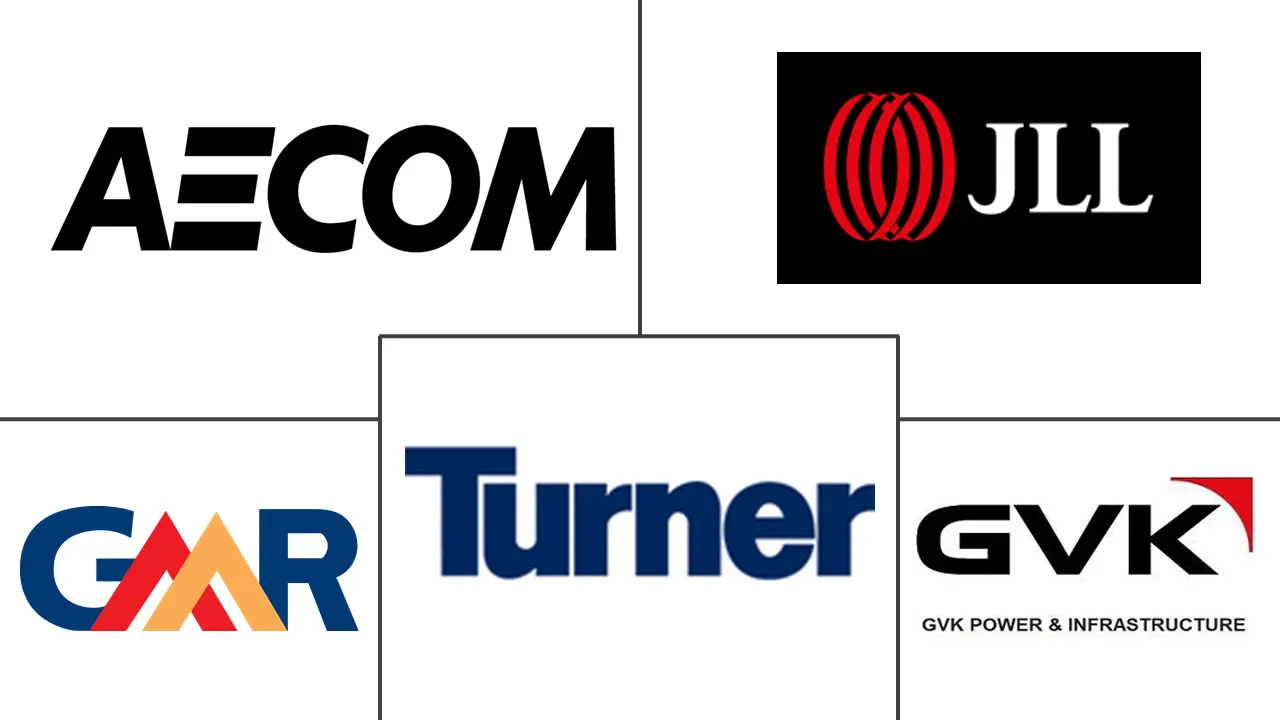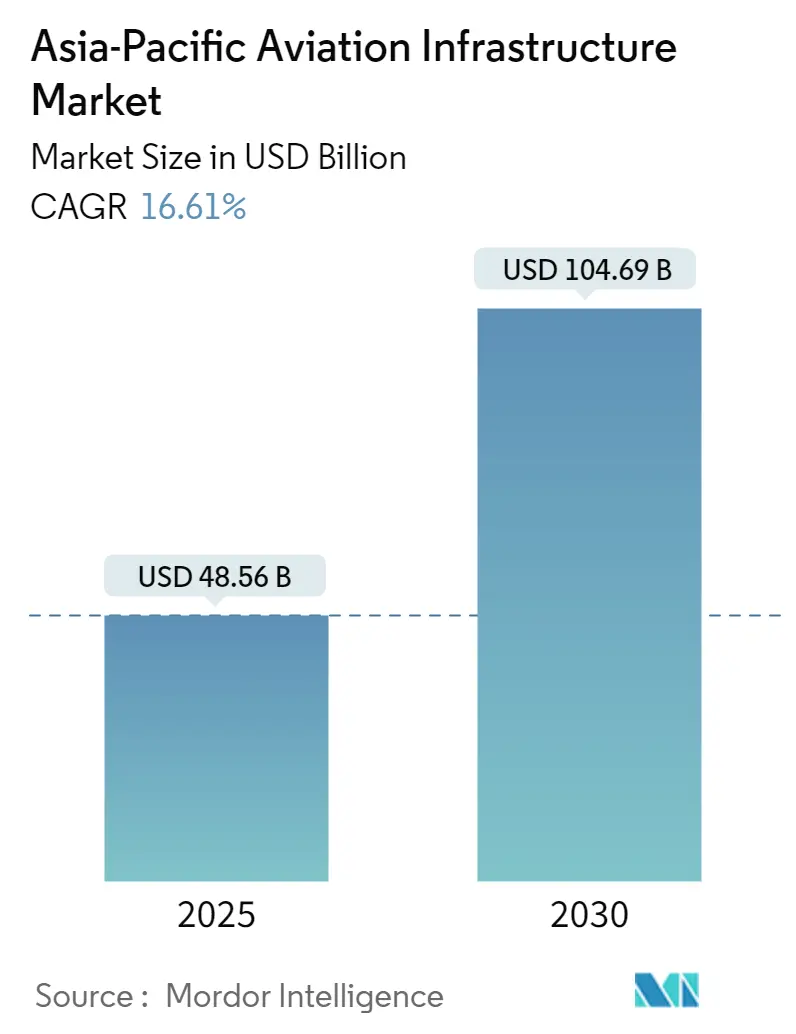
Asia-Pacific Aviation Infrastructure Market Analysis by Mordor Intelligence
The Asia-Pacific Aviation Infrastructure Market size is estimated at USD 48.56 billion in 2025, and is expected to reach USD 104.69 billion by 2030, at a CAGR of 16.61% during the forecast period (2025-2030).
The COVID-19 pandemic had a significant impact on all sectors, including the aviation industry. Due to restrictions on air travel, the overall passenger traffic declined by 60% to 65%. However, as the situation normalized in the fiscal year 2021-2022, the number of air passengers increased, leading to the unfreezing of standby orders of commercial aircraft and an increase in orders from airline companies. As of December 2022, the total traffic measured in revenue passenger kilometers (RPKs) rose by 39.9% compared to December 2021. Global traffic was then at 76.9% of the levels seen in December 2021.
In the Asia-Pacific region, the COVID-19 pandemic resulted in a decline in sales of aircraft in the commercial and general aviation segments in 2020. In the commercial sector, international passenger traffic continued to remain low in 2021. Nevertheless, domestic passenger traffic has been robustly growing in various countries since late 2020. A similar trend was witnessed in the general aviation sector in 2021 as the aircraft movement significantly increased compared to 2020. In Asia-Pacific, passenger and freight traffic rates are increasing, thus boosting the number of aircraft being handled by airports. This is propelling the demand for efficient and better ground handling systems and infrastructure at terminals. Due to the growing number of air passengers, several airports in the region need help with capacity management and other issues.
The airport infrastructure market in smaller cities in countries such as India and China is expected to witness growth, owing to the efforts taken by governments to promote air travel. As modern airports are being constructed with more terminal gates, longer runways, and advanced air traffic control systems, a rise in the demand for these infrastructure components is expected to propel the aviation infrastructure market in the Asia-Pacific region.
Asia-Pacific Aviation Infrastructure Market Trends and Insights
Commercial Airport Segment is Expected to Dominate the Market During the Forecast Period.
Currently, commercial air passenger traffic is witnessing high growth in Asia-Pacific, and it is also expected to continue to grow significantly in the future. Moreover, air freight transportation is expected to grow significantly during the forecast period.
In this regard, airport authorities are investing in the development of the existing infrastructure by constructing new terminals or restructuring the existing ones. For instance, In June 2021, Varaha Infra Limited got a contract from the Airports Authority of India for the development of a new greenfield airport in Gujarat, India. According to the assessment by the Airports Council International in 2022, the Asia-Pacific region continues to be a geography with significant potential for aviation, as 57% of the 300 planned airports globally are coming up in this part of the world. Such developments are expected to augment the market prospects during the forecast period.
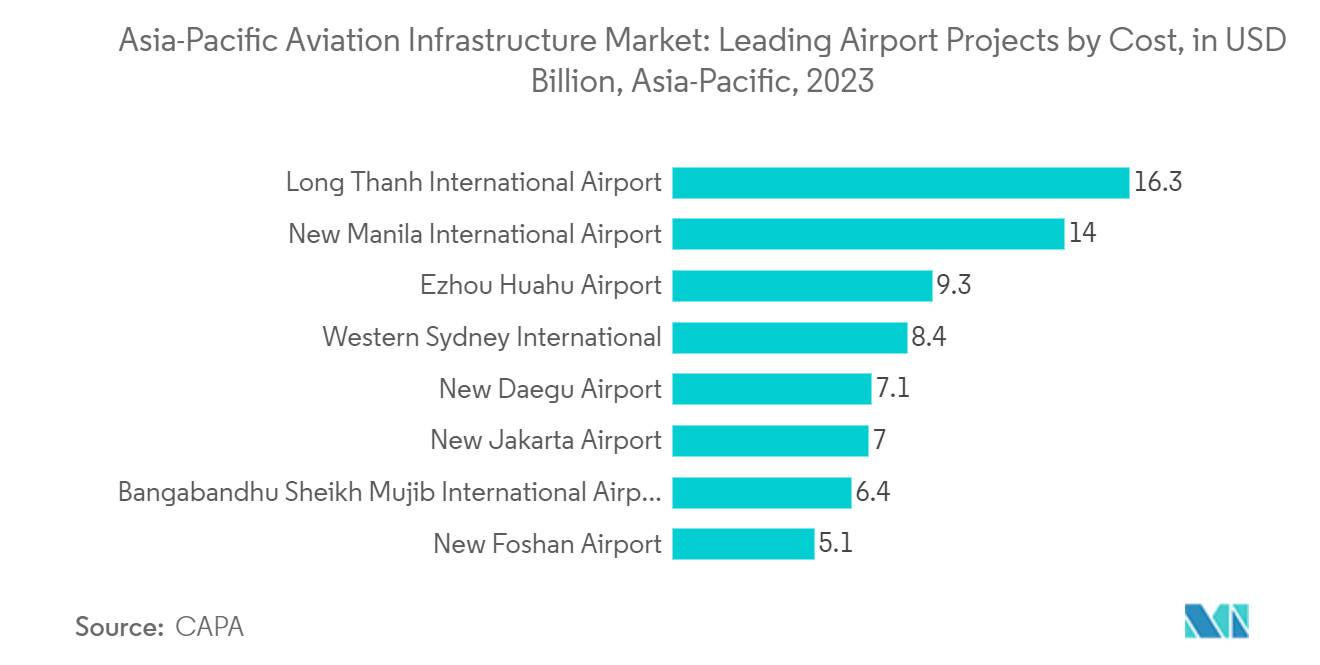
China is Expected to Lead the Market During the Forecast Period.
China held the highest shares in the market and continued its domination during the forecast period. The growth is attributed to the rising spending on the aviation sector, increasing demand for new aircraft, and growing airport construction projects across the country. Increasing air traffic and rising disposable income demand new aircraft, driving the market growth. China's major plane manufacturer, Commercial Aircraft Corporation of China (COMAC), predicted that China's aircraft fleet size will likely reach 9,957 by 2040, accounting for around 22 percent of the global passenger aircraft fleet, making China the world's largest single aviation market. The report stated that the country would take delivery of 9,084 passenger planes at or above the 50-seat class in the next two decades, valued at approximately USD 1.4 trillion.
Furthermore, the Civil Aviation Administration of China (CAAC) aims to add another 215 airports to reach a target of 450 by 2035. China envisions constructing an average of 14 airports annually until 2035 to help transform the country's aviation industry into a strategic asset of its economy. The construction of new airports would facilitate the creation of new routes and the induction of a new aircraft fleet to address the additional passenger traffic. Such developments would bolster the adoption of sophisticated infrastructure to ensure operational efficiency in the country.
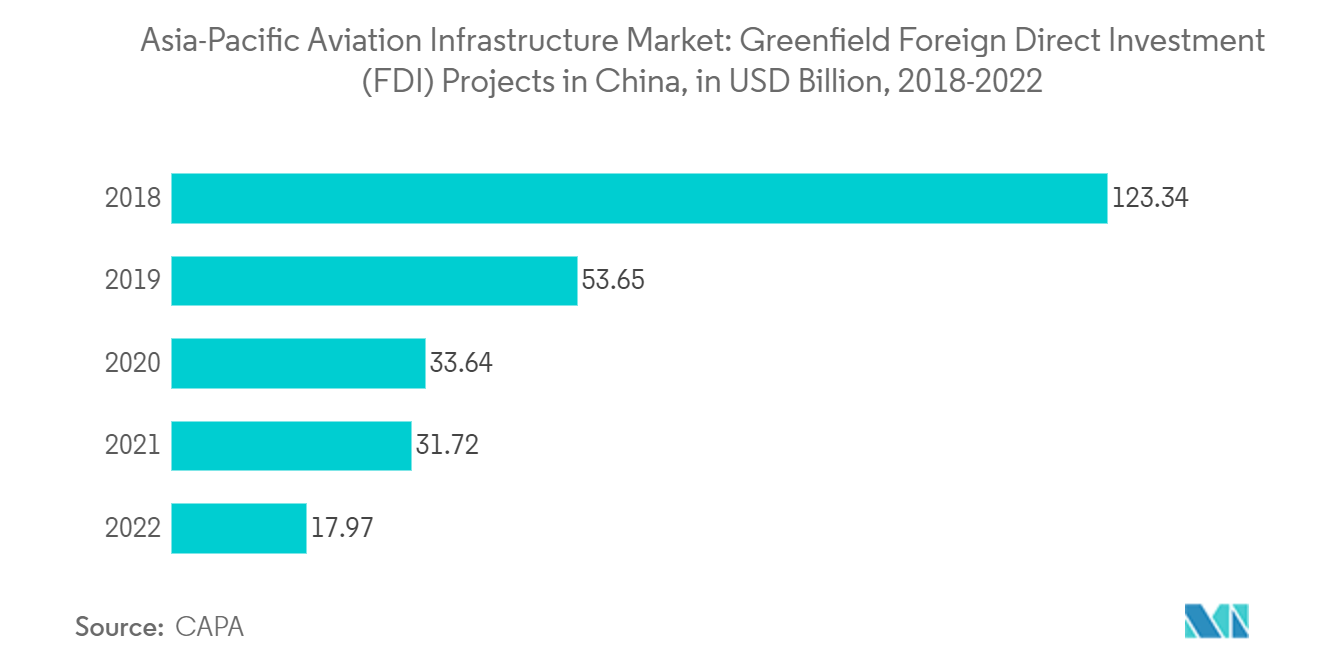
Competitive Landscape
The Asia-Pacific aviation infrastructure market is semi-consolidated. Some of the prominent market players include GMR Group, GVK Industries Limited, JLL Inc., AECOM Limited, and Turner Construction Company.
Major players are focusing on the constant development of the workforce to execute the on-time completion of infrastructure development projects. Aviation infrastructure development companies have to work in close synergy with airport authorities to improve airport operations by understanding barriers and requirements, which may help them achieve growth during the forecast period. For instance, in May 2022, the aviation ministry extended the term of the Concession Agreement of GMR Infrastructure Limited (GIL) for operating the Rajiv Gandhi International Airport in Hyderabad till 2068. Such developments are expected to enhance the competitive nature of the market in the future.
Asia-Pacific Aviation Infrastructure Industry Leaders
-
GMR Group
-
GVK Industries Limited
-
JLL Inc.
-
AECOM Limited
-
Turner Construction Company
- *Disclaimer: Major Players sorted in no particular order
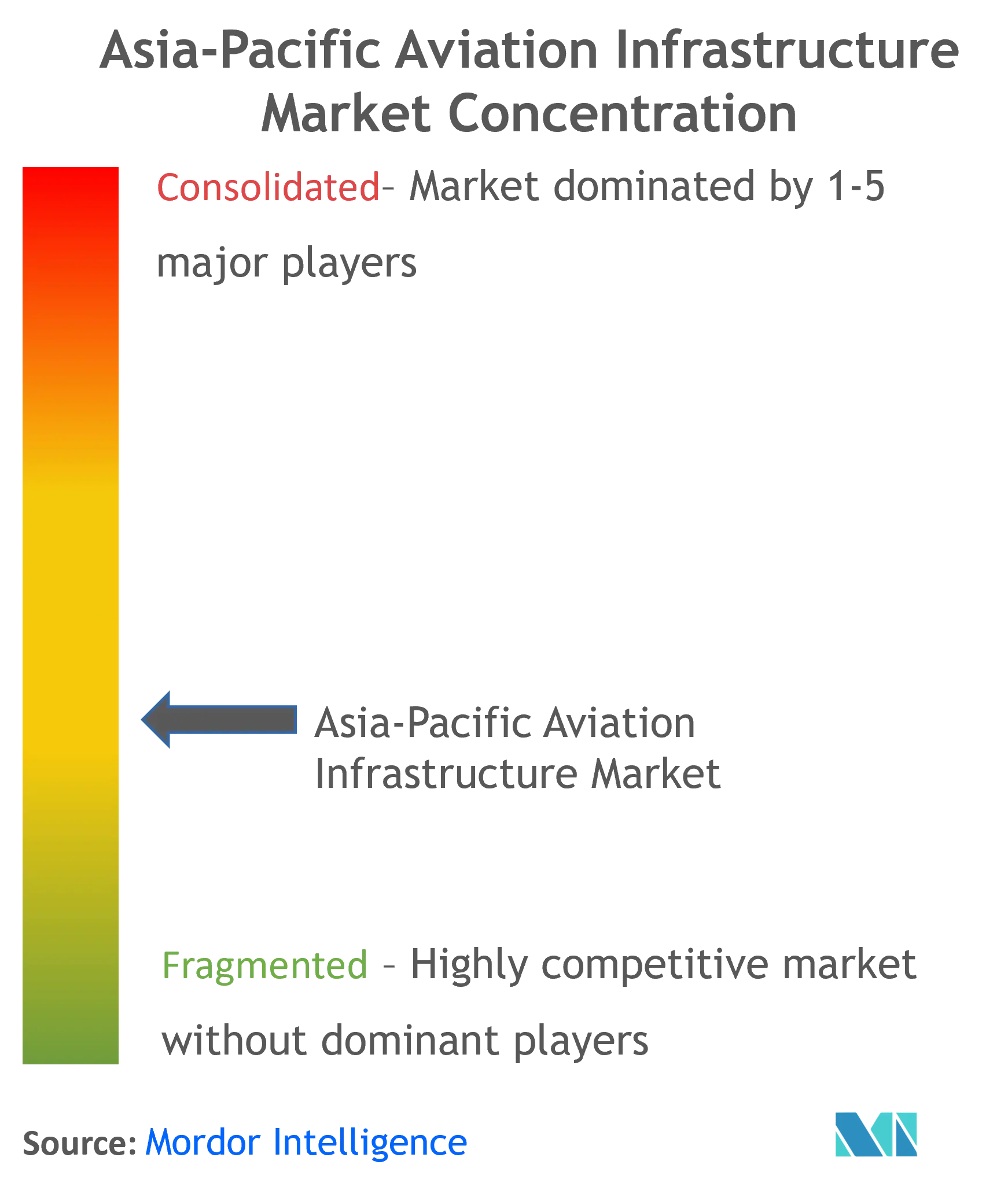
Recent Industry Developments
September 2023: A satellite terminal was opened at Suvarnabhumi Airport near Bangkok. The terminal can host up to 28 aircraft and handle 15 million passengers a year. Once fully operational, the airport's overall capacity will increase by 30% to 60 million passengers annually. The airport also expects a third runway to be completed in 2024.
February 2022: With a project value of USD 15.6 billion, the construction work started towards the SAA - Pudong International Airport Expansion Phase IV: Terminal 3 - Shanghai project was the largest Airport Terminal. The SAA - Pudong International Airport Expansion Phase IV: Terminal 3 - Shanghai project is located in China and was initially announced in 2020, with an estimated completion in 2030.
February 2022: Adani Airport Holdings, a subsidiary of the Adani Group and the Airports Authority of India, undertook the construction of an airport in Navi Mumbai, Maharashtra, India, for USD 2.3 billion. The new airport was projected to be one of the world's few "greenfield" international state-of-the-art airports, contributing world-class facilities. It was expected to have the capacity to handle 60 million passengers a year by 2030 when it reaches full capacity.
Asia-Pacific Aviation Infrastructure Market Report Scope
Aviation infrastructure refers to the physical facilities and systems that support the operation of aircraft, airports, and air navigation. It encompasses a wide range of components necessary for the safe, efficient, and reliable functioning of air transportation.
The Asia-Pacific aviation infrastructure market is segmented by airport type, infrastructure type, and geography. By airport type, the market is segmented into commercial airports, military airports, and general aviation airports. By infrastructure type, the market is segmented into terminals, control towers, taxiways and runways, aprons, hangars, and other infrastructure types. The report also offers the market size and forecasts for the aviation infrastructure market in major countries in the region. The study considers the planned investments for new airport construction, as well as the modernization plans for existing airports in the region. For each segment, the market size and forecasts are represented by value (USD).
| Commercial Airport |
| Military Airport |
| General Aviation Airport |
| Terminal |
| Control Tower |
| Taxiway and Runway |
| Apron |
| Hangars |
| Other Infrastructure Types |
| Asia-Pacific | China |
| India | |
| Japan | |
| South Korea | |
| Australia | |
| Rest of Asia-Pacific |
| Airport Type | Commercial Airport | |
| Military Airport | ||
| General Aviation Airport | ||
| Infrastructure Type | Terminal | |
| Control Tower | ||
| Taxiway and Runway | ||
| Apron | ||
| Hangars | ||
| Other Infrastructure Types | ||
| Geography | Asia-Pacific | China |
| India | ||
| Japan | ||
| South Korea | ||
| Australia | ||
| Rest of Asia-Pacific | ||
Key Questions Answered in the Report
How big is the Asia-Pacific Aviation Infrastructure Market?
The Asia-Pacific Aviation Infrastructure Market size is expected to reach USD 48.56 billion in 2025 and grow at a CAGR of 16.61% to reach USD 104.69 billion by 2030.
What is the current Asia-Pacific Aviation Infrastructure Market size?
In 2025, the Asia-Pacific Aviation Infrastructure Market size is expected to reach USD 48.56 billion.
Who are the key players in Asia-Pacific Aviation Infrastructure Market?
GMR Group, GVK Industries Limited, JLL Inc., AECOM Limited and Turner Construction Company are the major companies operating in the Asia-Pacific Aviation Infrastructure Market.
What years does this Asia-Pacific Aviation Infrastructure Market cover, and what was the market size in 2024?
In 2024, the Asia-Pacific Aviation Infrastructure Market size was estimated at USD 40.49 billion. The report covers the Asia-Pacific Aviation Infrastructure Market historical market size for years: 2019, 2020, 2021, 2022, 2023 and 2024. The report also forecasts the Asia-Pacific Aviation Infrastructure Market size for years: 2025, 2026, 2027, 2028, 2029 and 2030.
Page last updated on:
Asia-Pacific Aviation Infrastructure Market Report
Statistics for the 2025 Asia-Pacific Aviation Infrastructure market share, size and revenue growth rate, created by Mordor Intelligence™ Industry Reports. Asia-Pacific Aviation Infrastructure analysis includes a market forecast outlook for 2025 to 2030 and historical overview. Get a sample of this industry analysis as a free report PDF download.
